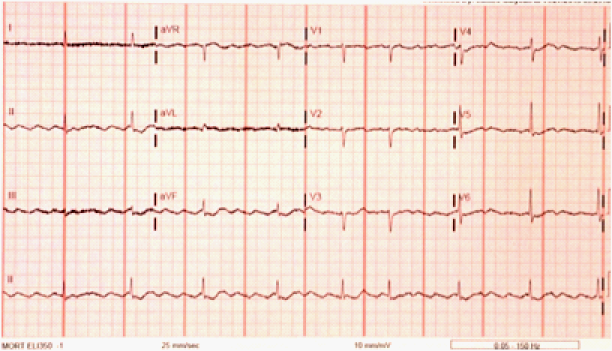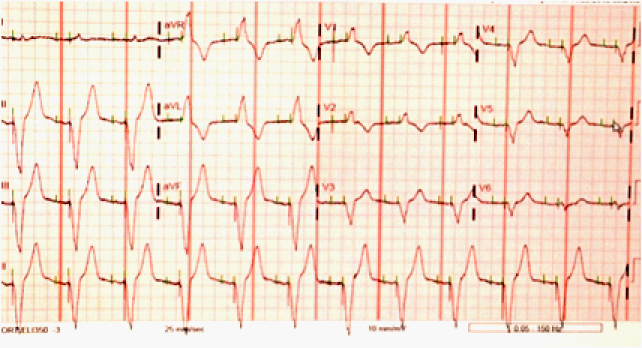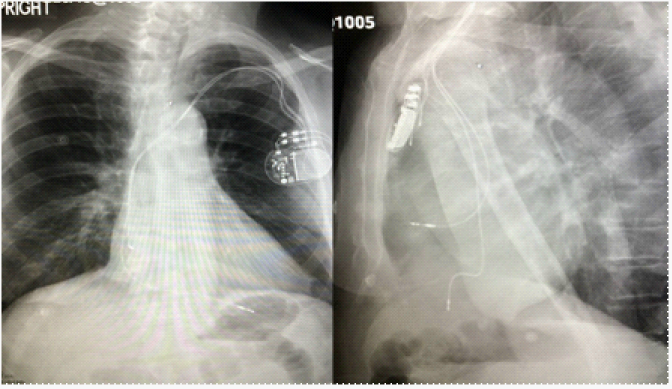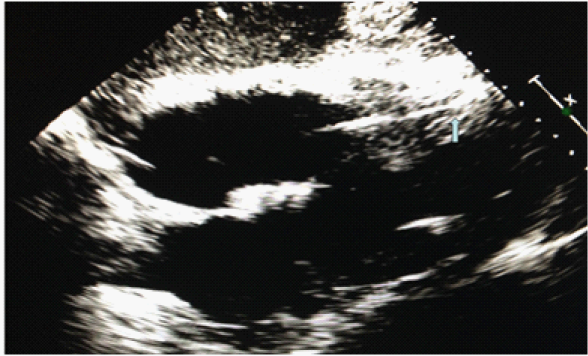
Correspondence:
Received: January 01, 1970 | Published: ,
Citation: DOI:
Download PDF
Abstract
RBBB pattern on surface electrocardiogram after right ventricular pacing is always concerning for lead malposition in left ventricle. However it can be a variant of normal pacing and careful assessment with chest X-ray, 2 D ECHO and ECG reassures normal pacing and can prevent unnecessary interventions.
Keywords:Right ventricular pacing; Right bundle branch block pattern; Lead malposition
Introduction
Cardiac pacing through a trans-venous catheter implanted in Right Ventricle (RV) usually produces a Left Bundle Branch (LBBB) morphology on surface electrocardiogram (ECG) [1]. There have been instances where a Right bundle branch (RBBB) pattern is seen on RV pacing as well. This raises the suspicion of septal perforation, lead malposition or a coronary sinus (CS) placement of lead. However this can be a variant of true uncomplicated RV pacing. We report a case of RBBB after RV pacing, reiterating the fact that this can be a absolutely benign pattern [2].
Case Report
75 year old man presented with gradually worsening exertional shortness of breath and easy fatigability. Nuclear stress test was abnormal for reversible ischemia and a cardiac catheterization was performed which showed a proximal Left anterior descending artery stenosis which was stented. He also had an atrial Flutter with slow ventricular rate of 50-60 bpm which occasionally dropped to 30 bpm (Figure 1). This was suggestive of significant Atrio-ventricular conduction abnormality. He underwent Flutter ablation after a Trans esophageal echo ruled out any intracardiac thrombus. Post successful ablation he had a HR of 40-50 bpm with complete AV dissociation hence a dual chamber pacemaker was implanted. St.Jude’s pacemaker was used with RV lead fixed to RV apex and Right atrial (RA) lead fixed to RA appendage and mode set at DDDR at lower pacing rate of 70/min. Measurements obtained were RA p- wave 2.7 mv, RA pacing atrial threshold 1mv at 4m.RV lead impedance was 980 ohm.
Post-operative chest X Ray confirmed correct lead placement. However the ECG was done which showed a RBBB morphology with mean QRS of -86 degrees (Figure 2). Repeat PA and lateral chest x-ray next day (Figure 3) and a 2D echocardiogram(2D ECHO) (Figure 4) were done to confirm the lead placement as well to r/o any inadvertent position of the lead. All modalities confirmed RV apical lead placement and uncomplicated RV pacing. Following Pacemaker implantation, patient’s breathlessness and fatigability were markedly improved. He was regularly followed in the clinic initially after 3 months and then every 6 months. He continues to be in an improved state of health.
Discussion
Commonly RV pacing causes LBBB pattern and LV pacing causes RBBB pattern on ECG [1]. Presence of RBBB in RV pacing raises the suspicion of inadvertent LV lead placement (through Atrial Septal Defect, Patent Foramen Ovale or septal perforation) , coronary sinus placement or transarterial placement crossing aortic valve and entering LV cavity [3,4]. These can have serious consequences and usually requires urgent revision of procedure. A thorough assessment with analysis of ECG, chest X-ray, and 2D ECHO can prove the placement of lead to be in uncomplicated RV apical position and hence prevent unnecessary intervention in such situation.
Coman and Trohman [5] and Okmen et al. [6] suggested an algorithm to separate RV and LV pacing morphology by using frontal axis and precordial transition point. After exclusion of pacing from proximal and mid septum, if there is a frontal axis of 0 to 90 degrees and precordial transition is by V3 then uncomplicated RV pacing can be distinguished from LV pacing with a sensitivity, specificity and positive predictive value of 86%,99% and 95% respectively. Our patient had a frontal axis of -86 degrees and transition by V3 hence correlating with proposed algorithm. They also suggested that if V1, V2 are placed one intercostal below than a normal LBBB morphology could be achieved. However our patient continued to show RBBB morphology even one space lower than usual position.
Many reasons have been postulated for RBBB pattern in RV pacing. Mower et al suggested that that there could be portions of interventricular septum which could be anatomical RV but functionally and electrically behave as LV. They also suggested that a pacemaker stimulus may enter the RBBB and can travel in a retrograde direction to the AV junction and down the LBBB. They also proposed that if the screw tip is deeper into the septal plane then it could activate LV early [7]. Barold et al. [8] said that combination of RV activation delay due to severe disease of RV conduction system and early penetration of electrical impulse into LV system could be responsible for this effect.

Figure 1: Atrial flutter with slow ventricular rate.

Figure 2: Post-operative ECG showing RBBB pattern.

Figure 3: PA and lateral Chest X ray showing normal position of lead.

Figure 4: 2D ECHO-sub costal view showing insertion of RV lead.
To conclude we would say that RBBB in a RV pacing could be a variant of normal uncomplicated RV apical pacing and does not necessarily mean a complication. A careful assessment with detailed analysis of ECG, pacing parameters, PA and lateral chest X-Ray and 2D ECHO can further prove the correct position of lead and should be undertaken before subjecting a patient for unnecessary intervention.
References
- Shima T, Ohnishi Y, Inoue T, Yoshida A, Shimizu H, et al. (1998) The relation between the pacing sites in the right ventricular outflow tract and QRS morphology in the 12-lead ECG. Jpn Circ J 62(6): 399-404.
- Yang YN, Yin WH, Young MS (2003) Safe right bundle branch block pattern during permanent right ventricular pacing. J Electrocardiol 36(1): 67-71.
- Raghavan C, Cashion WR, Spencer WH 3rd (1996) Malposition of transvenous pacing lead in the left ventricle. Clin Cardiol 19(4): 335-338.
- Lugo-Adams F, Rodriguez-Santiago A, Mercado-Crespo J, Rodriguez-Ospina L (2007) Paced right bundle branch block: identification and management of a malpositioned left ventricular pacemaker lead. Bol Asoc Med P R 99(1): 46-50.
- Coman JA, Trohman RG (1995) Incidence and electrocardiographic localization of safe right bundle branch block configurations during permanent ventricular pacing. Am J Cardiol 76(11): 781-784.
- Okmen E, Erdinler I, Oguz E, Akyol A, Turek O, et al. (2006) An electrocardiographic algorithm for determining the location of pacemaker electrode in patients with right bundle branch block configuration during permanent ventricular pacing. Angiology 57(5): 623-630.
- Mower MM, Aranaga CE, Tabatznik B (1967) Unusual patterns of conduction produced by pacemaker stimuli. Am Heart J 74(1): 24-28.
- Barold SS, Narula OS, Javier RP, Linhart JW, Lister JW, et al. (1969) Significance of right bundle-branch block patterns during pervenous ventricular pacing. Br Heart J 31(3): 285-290.

© . This is an open access article distributed under the terms of the,
which
permits unrestricted use, distribution, and build upon your work non-commercially.


